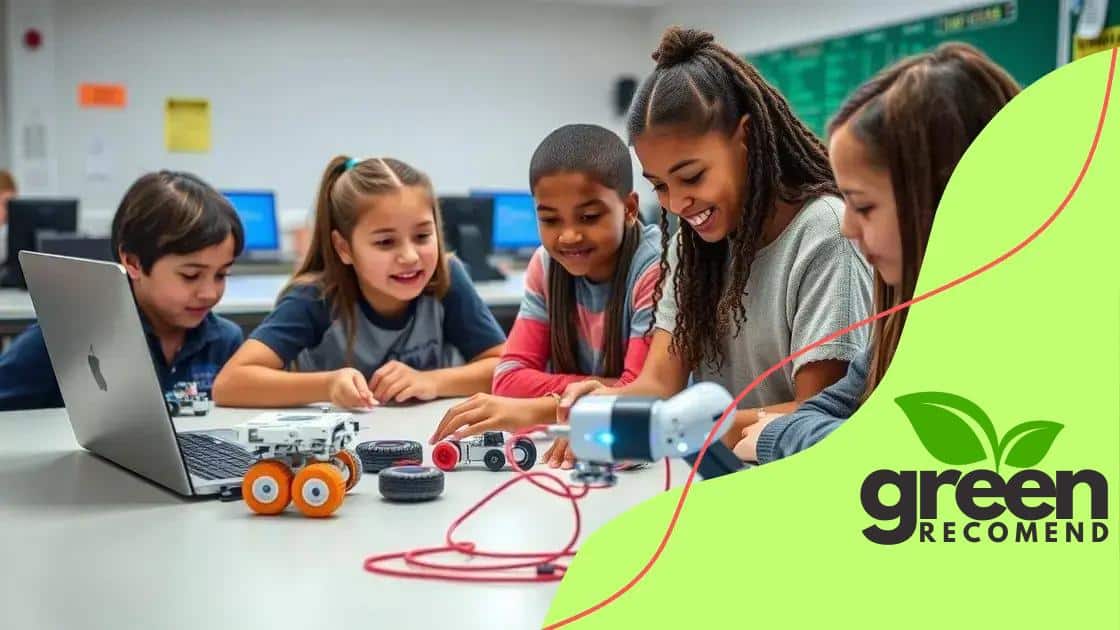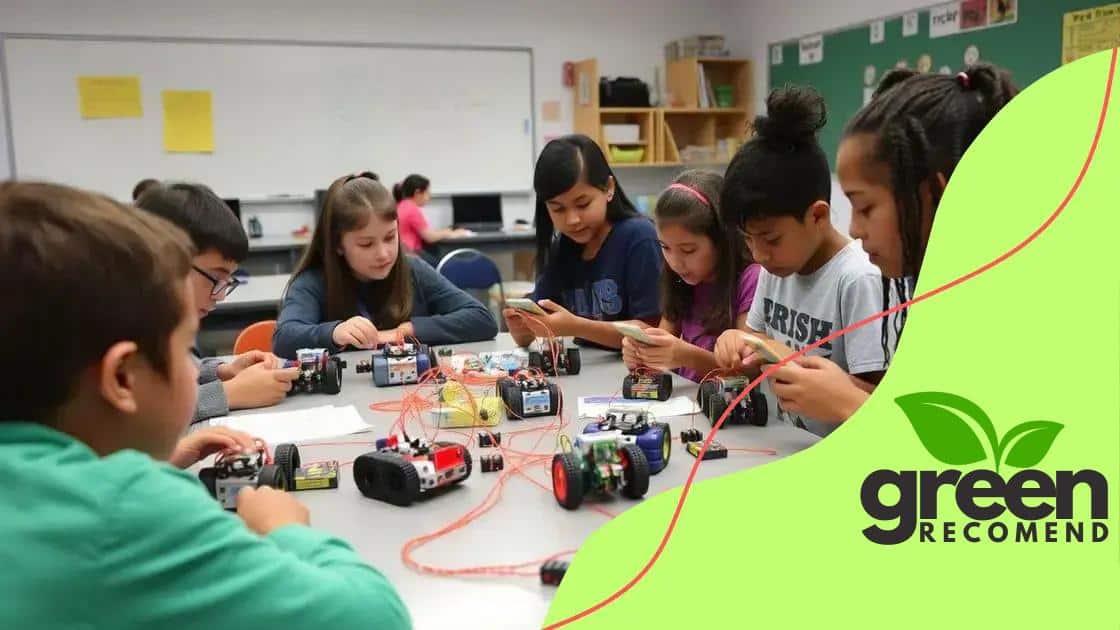Preparing students for AI, robotics, and automation industries

Engaging students in STEM initiatives through hands-on experiences, internships, and collaborative projects prepares them for careers in AI, robotics, and automation by enhancing their skills and fostering innovation.
Preparing students for AI, robotics, and automation industries is a crucial step in shaping their future careers. But how can we ensure that the next generation is ready for these rapidly evolving fields? Let’s delve into effective strategies and insights.
the importance of early exposure to technology
Early exposure to technology holds profound significance in molding young minds. Students who engage with technology from a young age are often better equipped for the demands of the AI, robotics, and automation industries. This foundation helps foster critical thinking, creativity, and adaptability.
Why Early Exposure Matters
When children are introduced to technology early on, they develop essential skills that are vital for future careers. These experiences can ignite interest and lead to greater proficiency in various tech-related areas.
- Enhances problem-solving abilities.
- Builds confidence in using advanced tools.
- Encourages teamwork and collaboration.
- Fosters creativity and innovation.
Furthermore, schools and parents can play a significant role in facilitating this exposure. By partnering together, they can create an environment where curiosity and learning thrive. Technology workshops in schools can provide a platform for students to interact with tools they may use in their future careers.
Engaging Students with Technology
Engaging students with technology goes beyond just hands-on experiences. Integrating technology into every subject can lead to a well-rounded education. For example, using robotics in a science class not only teaches the principles of engineering but also allows students to understand coding and programming in a fun and interactive way. Similarly, incorporating AI tools in math lessons can demystify complex concepts.
In addition to academic growth, exposure to technology also promotes digital literacy. In today’s world, understanding how to navigate various platforms and tools is crucial for success. This skill will serve students throughout their educational journey and into their careers.
skills needed for the future job market
As we look towards the future job market, certain skills stand out as essential for success. Students who develop these skills early will find themselves better prepared for careers in the AI, robotics, and automation industries.
Key Skills for Tomorrow’s Workforce
Emphasizing specific skills is crucial in education. Here are some key areas where students should focus:
- Critical thinking: Students should learn to analyze information and make effective decisions.
- Technical proficiency: Comfort with computers and various technologies is vital.
- Collaboration: Working well with others enhances problem-solving and leads to innovation.
- Adaptability: The ability to adjust to new technologies and job roles is increasingly important.
In addition to these skills, understanding coding and programming languages is becoming a necessary part of the curriculum. As many companies shift towards automation, being able to communicate with machines will be an invaluable asset. This knowledge empowers students to create their own technology solutions, preparing them for innovative roles.
The Role of STEM Education
STEM education plays a pivotal role in cultivating these essential skills. By integrating technology, engineering, and mathematics into the learning process, educators can help students develop a strong foundation. For example, robotics classes not only teach students how to build machines but also introduce them to complex problem-solving and creativity.
Moreover, engaging students in challenge-based learning can significantly enhance their learning experience. This approach encourages students to work on real-world problems. As they tackle these challenges, they enhance their ability to think critically and collaborate effectively with peers. Collaborative projects can also enrich their understanding of how different fields intersect in the job market of the future.
educational programs shaping future innovators

Educational programs are essential for shaping the innovators of tomorrow. These programs provide students with the tools they need to excel in the AI, robotics, and automation industries. By fostering creativity, critical thinking, and technical skills, these initiatives prepare students for a rapidly changing job market.
Types of Educational Programs
There are several types of programs designed to encourage innovation among students. Many schools now offer specialized curriculums that focus on the integration of technology into everyday learning. Some examples include:
- STEM Programs: Science, Technology, Engineering, and Mathematics programs aim to increase student engagement in these critical fields.
- Robotics Clubs: After-school clubs where students can work on robotics projects and competitions, enhancing their hands-on skills.
- Entrepreneurship Courses: These courses teach students how to turn their ideas into real-world solutions, fostering business acumen alongside creativity.
- Mentorship Programs: Pairing students with industry professionals can provide invaluable insights and real-world perspectives.
By actively participating in such programs, students gain practical knowledge that is crucial for their future careers. They learn to work collaboratively, solve complex problems, and think critically, all of which are necessary skills in today’s workforce.
Importance of Hands-On Learning
Hands-on learning experiences are vital for developing the skills needed in the future job market. When students engage in projects that require them to apply their knowledge, they deepen their understanding of the material.
Moreover, these experiences can spark a lasting interest in technology and innovation. For instance, when students build their own robots or develop software applications, they gain confidence in their abilities. This practical application of knowledge helps them connect theoretical concepts with real-world uses, making learning more engaging and impactful.
In addition, educational partnerships with local businesses can provide students with internships and project-based learning opportunities. These partnerships allow students to work on actual problems that companies face, giving them a taste of real-world challenges and solutions.
importance of internships and hands-on experience
The importance of internships and hands-on experience cannot be overstated for students aspiring to enter the AI, robotics, and automation industries. These opportunities provide a practical application of classroom knowledge, bridging the gap between theory and real-world scenarios.
Why Internships Matter
Internships offer students a chance to immerse themselves in a professional environment. They gain exposure to industry practices and expectations, which is incredibly beneficial. Here are some key reasons why internships are important:
- Real-World Experience: Interns develop practical skills that classroom learning cannot fully provide.
- Networking Opportunities: Building connections with industry professionals can lead to future job offers.
- Enhanced Resumes: Employers often favor candidates with relevant experience, making internships a valuable addition.
- Career Exploration: Internships allow students to test different roles within a field, helping them discover their passions.
By participating in internships, students not only build their resumes but also gain confidence in their abilities and proficiency in their chosen fields. This self-assurance is critical as they transition from education to employment.
Value of Hands-On Experience
Hands-on experience complements theoretical learning. Whether through internships, workshops, or collaborative projects, practical engagement helps solidify students’ understanding.
For instance, when students work on a robotics project, they learn to apply their knowledge of physics, engineering, and coding in a tangible way. This experiential learning reinforces the concepts they study in class, making them more memorable.
Furthermore, hands-on experience promotes critical thinking and problem-solving skills. Students encounter real challenges that require them to think outside the box and innovate solutions. These experiences encourage a growth mindset, showing students that failure is often a step towards success.
how to engage students in STEM initiatives
Engaging students in STEM initiatives is crucial for fostering the next generation of innovators. By incorporating interactive and immersive experiences, educators can inspire enthusiasm for science, technology, engineering, and mathematics. These initiatives can be tailored to meet the interests and learning styles of students.
Interactive Learning Environments
Creating interactive learning environments encourages students to explore STEM concepts hands-on. Using projects, experiments, and technology can spark curiosity. Some effective methods include:
- Hands-on Workshops: Offering workshops where students can build robots or conduct experiments helps make learning tangible.
- Field Trips: Visiting science centers, technology companies, or engineering firms exposes students to real-world applications of STEM.
- Coding and Robotics Competitions: Encouraging participation in competitions promotes teamwork and problem-solving.
- Guest Speakers: Inviting professionals from STEM fields to share their experiences can inspire students.
When students see the real-world implications of STEM subjects, they become more invested in their education. For example, projects that relate to everyday challenges can make learning relevant and exciting.
Fostering a Collaborative Culture
Collaboration plays a vital role in engaging students. Encouraging group projects and discussions helps students learn from each other and develop communication skills. Creating a culture where students feel safe to express ideas fosters creativity and innovation.
Teachers can implement collaborative learning by breaking students into small groups for projects, allowing them to share responsibilities. This approach not only enhances their understanding of STEM but also builds teamwork skills that are essential for the workforce.
Additionally, offering after-school clubs focusing on STEM can provide students with a space to explore their interests further. These clubs often encourage creative problem-solving and critical thinking while allowing students to work on projects at their own pace.
In summary, engaging students in STEM initiatives is crucial for their future success. By offering hands-on experiences through internships, workshops, and collaborative projects, we can ignite their interest in the AI, robotics, and automation industries. These interactions not only build essential skills but also foster creativity and problem-solving abilities. As we continue to support and cultivate young minds, we ensure a brighter future driven by innovation and technology.
\n\n
\n
FAQ – Engaging Students in STEM Initiatives
Why is engaging students in STEM important?
Engaging students in STEM helps spark their interest in science, technology, engineering, and math, preparing them for future careers.
What are effective ways to get students involved in STEM?
Hands-on workshops, competitions, and collaborative projects are great ways to engage students in STEM activities.
How do internships benefit students in STEM fields?
Internships provide real-world experience, networking opportunities, and help students apply their knowledge in practical settings.
What role does collaboration play in STEM learning?
Collaboration fosters teamwork, enhances problem-solving skills, and allows students to learn from each other in a dynamic environment.





